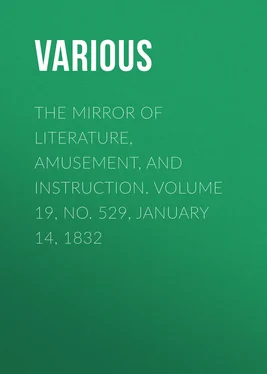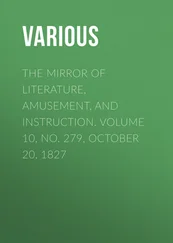Various - The Mirror of Literature, Amusement, and Instruction. Volume 19, No. 529, January 14, 1832
Здесь есть возможность читать онлайн «Various - The Mirror of Literature, Amusement, and Instruction. Volume 19, No. 529, January 14, 1832» — ознакомительный отрывок электронной книги совершенно бесплатно, а после прочтения отрывка купить полную версию. В некоторых случаях можно слушать аудио, скачать через торрент в формате fb2 и присутствует краткое содержание. Жанр: foreign_antique, periodic, Развлечения, foreign_edu, на английском языке. Описание произведения, (предисловие) а так же отзывы посетителей доступны на портале библиотеки ЛибКат.
- Название:The Mirror of Literature, Amusement, and Instruction. Volume 19, No. 529, January 14, 1832
- Автор:
- Жанр:
- Год:неизвестен
- ISBN:нет данных
- Рейтинг книги:5 / 5. Голосов: 1
-
Избранное:Добавить в избранное
- Отзывы:
-
Ваша оценка:
- 100
- 1
- 2
- 3
- 4
- 5
The Mirror of Literature, Amusement, and Instruction. Volume 19, No. 529, January 14, 1832: краткое содержание, описание и аннотация
Предлагаем к чтению аннотацию, описание, краткое содержание или предисловие (зависит от того, что написал сам автор книги «The Mirror of Literature, Amusement, and Instruction. Volume 19, No. 529, January 14, 1832»). Если вы не нашли необходимую информацию о книге — напишите в комментариях, мы постараемся отыскать её.
The Mirror of Literature, Amusement, and Instruction. Volume 19, No. 529, January 14, 1832 — читать онлайн ознакомительный отрывок
Ниже представлен текст книги, разбитый по страницам. Система сохранения места последней прочитанной страницы, позволяет с удобством читать онлайн бесплатно книгу «The Mirror of Literature, Amusement, and Instruction. Volume 19, No. 529, January 14, 1832», без необходимости каждый раз заново искать на чём Вы остановились. Поставьте закладку, и сможете в любой момент перейти на страницу, на которой закончили чтение.
Интервал:
Закладка:
4 4 Sketches of New and Old Sleaford, County of Lincoln, and of several places in the Neighbourhood, p. 224. 8vo Baldwin and Co.on the topography of the neighbourhood, soon after his visit: he says, "The sepulchre, of which there are not many specimens now remaining, consists of a series of richly ornamented niches, the largest of which represents the tomb, having angels standing beside it; the side niches have the Maries and other appropriate figures, and in the lower niches are the Roman soldiers reposing; these niches have rich canopies, and are separated by buttresses and rich finials, having all the spaces covered by very rich foliage." He further observes, that "the stalls exhibit a specimen of pure decorated work, as rich as the finest sculpture of foliage and small figures can render it, and hardly surpassed by any in the kingdom, and the sepulchre is of the same excellent character. The various small ornaments about these stalls and niches form one of the best possible studies for enrichments of this date: and it is almost peculiar to this church, that there is nothing about it, except what is quite modern, that is not of the same style of architecture."
As the above gentleman's description of the present state of the church at Heckington will give a clearer idea of many others in the county of Lincoln, we perhaps cannot do better than close this account with it. "This beautiful church, of pure decorated character, is one of the most perfect models in the kingdom, having, with one exception, (that of the groined or interior ceiling which is wanting, and appears never to have been prepared for,) every feature of a fine church, of one uniform style, without any admixture of later or earlier work. Its mutilations are comparatively small, consisting only in the destruction of the tracey of the north transept window, and some featherings in other windows, and the building and wall to enclose a vestry. The plan of the church is a west tower and spire, nave and aisles, spacious transepts, and a large chancel, with a vestry attached to the north side. The nave has a well proportioned clesestory. There is a south porch, a rich font, the tomb of an ecclesiastic, and the assemblage of niches before described. In the chancel and some of the church walls are very good brackets. The vestry has a crypt below it. Fully to describe this church would require a much larger space than can be allotted to it, but it may be well to remark, that every part of the design and execution is of the very best character, equal to any in the kingdom."
That this church was built on or near to the site of the one given by Gilbert de Guant, the style of architecture being of much later date, fully demonstrates; and it is more than probable that on its rebuilding, the patent of Edward III. was obtained. Certain it is that no specimen of an earlier style now remains; but tradition says that the foundation of the church was laid in the year 1101, and the building completed in A.D. 1104, at a cost only of £433. 9 s . 7 d . This statement, if worthy of credit, must be referred to an earlier and less costly edifice than the present.
J.H.S.
TRAVELING NOTES IN SOUTH WALES
Guernsey, Dec. 17, 1831.
Your ingenious and talented correspondent, Vyvyan , in writing on the shrimp, (the Mirror , p. 361, vol. xviii.) remarks that "The sea roamer may often have observed numbers of little air-holes in the sand, which expand as the sun advances. If he stirs it with his foot, he will cause a brood of young shrimps, who will instantly hop and jump about the beach in the most lively manner," &c.: these "jumpers" as they are facetiously called, are not shrimps, but sea-fleas, and they possess the elasticity for which their namesakes are so remarkable. They are as different as possible from young shrimps; and if "old shrimps" could "tell tales," I doubt not but that on inquiring of them, they would tell their "companions at breakfast table" the same thing. Your correspondent further adds, that "strange stories are told of the old shrimp," and I think, on investigation, he will find that he has told a very "strange story" of young shrimps. In a future communication I will give you a correct account or history of the shrimp, (if it be acceptable,) from the time when it is first spawned until it arrives at perfection.
H.W.
Vyvyan has not in his Notes named any county but South Wales, generally, where he says, "Any person who can enclose a portion of land around his cottage or otherwise, in one night, becomes owner thereof in fee." These persons in Wales are called Encroachers, and are liable to have ejectments served upon them by the Lord of the Manor, (which is often the case) to recover possession. The majority of the Encroachers pay a nominal yearly rent to the Lord of the Manor for allowing them to occupy the land. If they possess these encroachments for sixty years without any interruption, or paying rent, then they become possessed of the same. It is usual to present the Encroachments at a Court Leet held for the manor, and upon perambulating the manor, which is generally done every three or four years, these encroachments are thrown out again to the waste or common.
J.P.
*** We readily insert these corrections of Vyvyan's "Notes," especially as we believe our readers to take considerable interest in their accuracy.
THE SKETCH-BOOK
MY FIRE
On new year's morning, soon after daybreak, I entered my study, which is a little room some eight feet square, and from a wayward fancy of my own, closely resembles the cell of an alchymist. Its walls are hung with black drapery, on which appear the mystical signs of the planetary bodies, Hebrew, Persian, and various cabalistic characters, the dark enigmas of the work of transmutation, and the invocations or prayers for success employed by the alchymist. Here and there pieces of their quaint and uncouth shaped apparatus, the aludel, the alembic, and the alkaner, the pelican, the crucible, and the water-bath, occupy their respective stations. The clumsy, heavy, oaken table in the centre is covered with copies of scarce and valuable alchymical tracts, in company with the caput mortum and the hour-glass. A few antiques, consisting of half-a-dozen cloth-yard arrows, the stout yew bow of the green clad yeoman, the ponderous mace and helmet of the valiant knight, and other relics of the days of chivalry, complete the decorations of this my sanctum.
In consequence of its dark and gloomy aspect, and the feeling of awe with which the family and servants regard its mystical contents, I have its undisturbed enjoyment; nobody feels a wish to enter it even in the day time, and I verily believe they would not do so at the witching hour of night, lest the mystical signs should take summary vengeance on their unhallowed intrusion.
The neighbours imagine me to be an adept in the "black art," an astrologer, or a fortune-teller, but I have no pretentions whatever to any such titles; this report has got abroad in consequence of a maid-servant having once had the temerity to peep through the key-hole, and observed on the wall opposite her "line of sight," some triangular characters. She had been in the habit of poring over a dream book, and the art of casting nativities; the Prophetic Almanac was her oracle, and its terrific title-page she informed her fellow servant "had just those queer triangle things as was hung on the walls of young master's study." She was "sure that he could tell her fortune." This important intelligence, delivered with due confidence to her fellow servant, of course spread like wildfire among the other occupants of the "lower regions," and from them amongst the handmaidens of sundry other dwellings. Thus has my astrological character been established.
Читать дальшеИнтервал:
Закладка:
Похожие книги на «The Mirror of Literature, Amusement, and Instruction. Volume 19, No. 529, January 14, 1832»
Представляем Вашему вниманию похожие книги на «The Mirror of Literature, Amusement, and Instruction. Volume 19, No. 529, January 14, 1832» списком для выбора. Мы отобрали схожую по названию и смыслу литературу в надежде предоставить читателям больше вариантов отыскать новые, интересные, ещё непрочитанные произведения.
Обсуждение, отзывы о книге «The Mirror of Literature, Amusement, and Instruction. Volume 19, No. 529, January 14, 1832» и просто собственные мнения читателей. Оставьте ваши комментарии, напишите, что Вы думаете о произведении, его смысле или главных героях. Укажите что конкретно понравилось, а что нет, и почему Вы так считаете.












